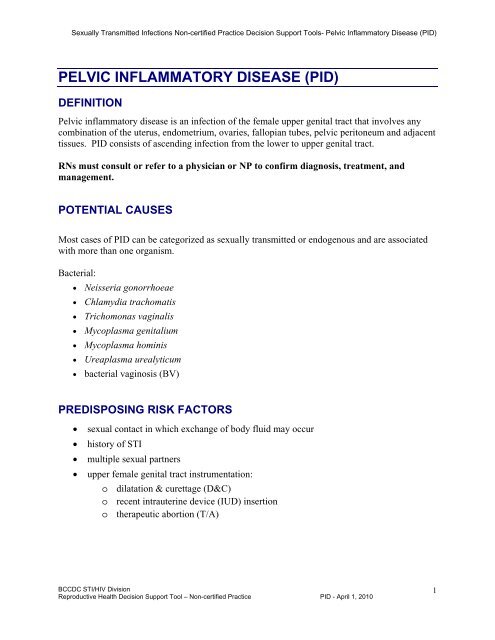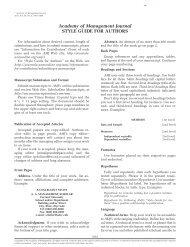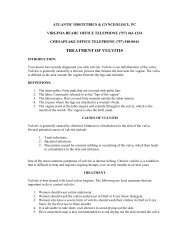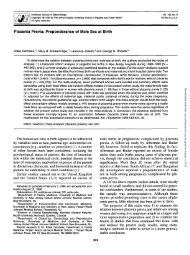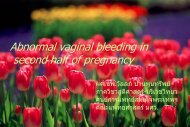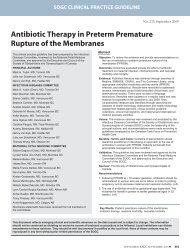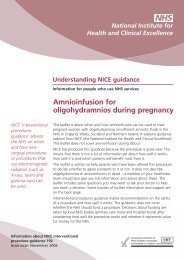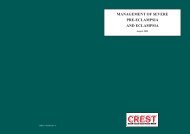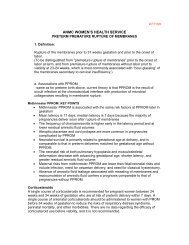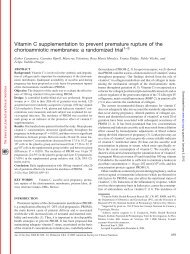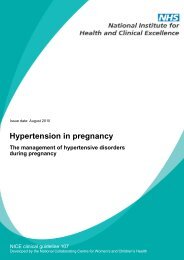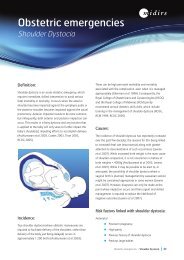PELVIC INFLAMMATORY DISEASE (PID)
PELVIC INFLAMMATORY DISEASE (PID)
PELVIC INFLAMMATORY DISEASE (PID)
Create successful ePaper yourself
Turn your PDF publications into a flip-book with our unique Google optimized e-Paper software.
Sexually Transmitted Infections Non-certified Practice Decision Support Tools- Pelvic Inflammatory Disease (<strong>PID</strong>)<br />
<strong>PELVIC</strong> <strong>INFLAMMATORY</strong> <strong>DISEASE</strong> (<strong>PID</strong>)<br />
DEFINITION<br />
Pelvic inflammatory disease is an infection of the female upper genital tract that involves any<br />
combination of the uterus, endometrium, ovaries, fallopian tubes, pelvic peritoneum and adjacent<br />
tissues. <strong>PID</strong> consists of ascending infection from the lower to upper genital tract.<br />
RNs must consult or refer to a physician or NP to confirm diagnosis, treatment, and<br />
management.<br />
POTENTIAL CAUSES<br />
Most cases of <strong>PID</strong> can be categorized as sexually transmitted or endogenous and are associated<br />
with more than one organism.<br />
Bacterial:<br />
Neisseria gonorrhoeae<br />
Chlamydia trachomatis<br />
Trichomonas vaginalis<br />
Mycoplasma genitalium<br />
Mycoplasma hominis<br />
Ureaplasma urealyticum<br />
bacterial vaginosis (BV)<br />
PREDISPOSING RISK FACTORS<br />
<br />
<br />
<br />
<br />
sexual contact in which exchange of body fluid may occur<br />
history of STI<br />
multiple sexual partners<br />
upper female genital tract instrumentation:<br />
o dilatation & curettage (D&C)<br />
o recent intrauterine device (IUD) insertion<br />
o therapeutic abortion (T/A)<br />
BCCDC STI/HIV Division<br />
Reproductive Health Decision Support Tool – Non-certified Practice <strong>PID</strong> - April 1, 2010<br />
1
Sexually Transmitted Infections Non-certified Practice Decision Support Tools- Pelvic Inflammatory Disease (<strong>PID</strong>)<br />
TYPICAL FINDINGS<br />
Sexual Health History<br />
<br />
<br />
unprotected sexual contact with at least one partner<br />
recent IUD insertion or upper genital tract instrumentation<br />
PHYSICAL ASSESSMENT FINDINGS<br />
Cardinal Signs<br />
<br />
<br />
lower abdominal pain – usually bilateral<br />
abnormal bimanual pelvic exam that includes:<br />
o adenexal tenderness<br />
o fundal tenderness<br />
o cervical motion tenderness<br />
Additional Signs & Symptoms<br />
<br />
<br />
<br />
<br />
<br />
<br />
<br />
<br />
fever >38ºC<br />
dyspareunia<br />
abnormal vaginal bleeding or spotting<br />
abnormal vaginal discharge<br />
urinary frequency<br />
pelvic pain<br />
nausea or vomiting<br />
low back pain<br />
Differential Diagnosis:<br />
It is important to rule out other potential causes of lower abdominal pain including ectopic<br />
pregnancy, ovarian cysts, and gastrointestinal causes including appendicitis.<br />
BCCDC STI/HIV Division<br />
Reproductive Health Decision Support Tool – Non-certified Practice <strong>PID</strong> - April 1, 2010<br />
2<br />
prgmea.com
Sexually Transmitted Infections Non-certified Practice Decision Support Tools- Pelvic Inflammatory Disease (<strong>PID</strong>)<br />
DIAGNOSTIC TESTS:<br />
cervical swab for NAAT (GC/CT)<br />
AND<br />
cervical swab for GC culture & sensitivity<br />
AND<br />
urine pregnancy test<br />
AND<br />
vaginal swabs<br />
vaginal slide smear for trichomonas, yeast, and bacterial vaginosis<br />
swab for KOH whiff test<br />
vaginal pH<br />
AND<br />
bimanual exam for tenderness<br />
CLINICAL EVALUATION<br />
Clients who present with suspected <strong>PID</strong> as defined by pelvic tenderness and lower abdominal<br />
pain during the bimanual exam require referral to physician/NP to confirm the diagnosis prior to<br />
receiving treatment.<br />
MANAGEMENT AND INTERVENTIONS<br />
Goals of Treatment:<br />
<br />
<br />
<br />
<br />
<br />
commence rapid treatment to preserve fertility<br />
treat infection<br />
alleviate symptoms<br />
prevent further complications<br />
prevent spread of infection<br />
NOTE: If an IUD is present, the device should NOT BE REMOVED until after antibiotic<br />
therapy has been initiated and at least 2 doses of antibiotics have been taken.<br />
BCCDC STI/HIV Division<br />
Reproductive Health Decision Support Tool – Non-certified Practice <strong>PID</strong> - April 1, 2010<br />
3<br />
prgmea.com
Sexually Transmitted Infections Non-certified Practice Decision Support Tools- Pelvic Inflammatory Disease (<strong>PID</strong>)<br />
Criteria for Potential Hospitalization:<br />
The following criteria may indicate the need for hospitalization or parenteral therapy:<br />
<br />
<br />
<br />
surgical emergencies such as appendicitis or ectopic pregnancy that cannot be excluded<br />
client is pregnant<br />
client cannot tolerate oral treatments<br />
client is under the age of 19<br />
<br />
<br />
<br />
<br />
<br />
client has severe abdominal pain<br />
client has abdominal guarding, rigidity, or rebound tenderness<br />
client has severe nausea, vomiting, or a fever >38.5ºC<br />
client has underlying chronic illnesses such as diabetes, HIV or active Hepatitis infection<br />
concerns with the client’s ability to complete oral antibiotic therapy that may require<br />
parenteral treatment<br />
TREATMENT OF CHOICE - USE ONLY IN CONSULT WITH PHYSICIAN<br />
OR NP<br />
First Choice – <strong>PID</strong> Treatment without concurrent BV<br />
Cefixime 800mg po in a single dose AND doxycyline 100 mg PO BID for 10 days<br />
If BV is clinically diagnosed in the presence of <strong>PID</strong> then treatment for BV is added to the<br />
cefixime and doxycyline regime:<br />
First Choice – <strong>PID</strong> Treatment with concurrent BV<br />
Cefixime 800mg po in a single dose AND doxycyline 100 mg po bid for 10 days AND<br />
metronidazole 500 mg po bid for 10 days<br />
Note:<br />
1. Treatment for <strong>PID</strong> covers possibility of infection by chlamydia and gonorrhea;<br />
2. It is important for clients to abstain from sexual contact for 10 days after starting<br />
treatment until all partners have completed treatment;<br />
3. Do not use cefixime if allergic to cephalosporins or penicillin.<br />
4. Do not use doxyclycline if allergic to tetracycline<br />
BCCDC STI/HIV Division<br />
Reproductive Health Decision Support Tool – Non-certified Practice <strong>PID</strong> - April 1, 2010<br />
4<br />
prgmea.com
Sexually Transmitted Infections Non-certified Practice Decision Support Tools- Pelvic Inflammatory Disease (<strong>PID</strong>)<br />
ALTERNATE TREATMENT - USE ONLY IN CONSULT WITH<br />
PHYSICIAN OR NP<br />
Second Choice - <strong>PID</strong> Treatment without concurrent BV<br />
Cefixime 800mg po in a single dose AND Azithromycin 1 gm po in a single dose<br />
If BV is clinically diagnosed in the presence of <strong>PID</strong> then treatment for BV is added to the<br />
cefixime and azithromycin regime:<br />
Second Choice - <strong>PID</strong> Treatment with concurrent BV<br />
Cefixime 800mg po in a single dose AND Azithromycin 1 gm po in a single dose<br />
AND metronidazole 500 mg po bid for 10 days<br />
NOTE: Clients who receive Azithromycin as alternate treatment may require repeat treatment<br />
(Azithromycin 1 gm po in a single dose) at the follow-up visit. This decision is made in<br />
consultation with the physician/NP.<br />
TREATMENT OF CONTACT(S) TO <strong>PID</strong><br />
Treat and offer screening to all sexual contacts within the past 60 days. See treatment of contacts<br />
DST for treatment regime.<br />
PREGNANT OR BREASTFEEDING WOMEN<br />
Refer all pregnant or breastfeeding women to a physician or NP.<br />
PARTNER COUNSELLING AND REFERRAL<br />
Counsel clients to notify sexual contacts within the previous 60 days that they require testing and<br />
treatment to cover uncomplicated chlamydia and gonorrhea.<br />
Commence formal follow-up and partner notification processes if any reportable infections are<br />
diagnosed from the laboratory submitted specimens.<br />
MONITORING AND FOLLOW-UP<br />
Clients treated for <strong>PID</strong> should return to clinic for repeat assessment (bimanual exam) to ensure<br />
pelvic tenderness is resolving 2–3 days after the onset of treatment and again 4–7 days after<br />
treatment is completed.<br />
BCCDC STI/HIV Division<br />
Reproductive Health Decision Support Tool – Non-certified Practice <strong>PID</strong> - April 1, 2010<br />
5<br />
prgmea.com
Sexually Transmitted Infections Non-certified Practice Decision Support Tools- Pelvic Inflammatory Disease (<strong>PID</strong>)<br />
POTENTIAL COMPLICATIONS<br />
<br />
<br />
<br />
<br />
<br />
<br />
Fitz-Hugh-Curtis syndrome<br />
tubo-ovarian abcess<br />
ectopic pregnancy<br />
chronic pelvic pain<br />
tubal factor infertility<br />
recurrent <strong>PID</strong><br />
CLIENT EDUCATION /DISCHARGE INFORMATION<br />
Counsel client:<br />
<br />
<br />
<br />
<br />
<br />
<br />
<br />
<br />
<br />
to return for follow up assessment for pelvic tenderness in 48 to 72 hours after first visit<br />
and 4 to 7 days after treatment is finished<br />
regarding the importance of revisiting health care provider if symptoms worsen or persist<br />
regarding the appropriate use of medications (dosage, side effects, and need for retreatment<br />
if dosage not completed)<br />
to avoid sexual contact with current partners until they and partners have completed<br />
screening and treatment<br />
to inform last sexual contact and all sexual contacts within the last 60 days that they<br />
require testing and treatment<br />
regarding harm reduction measures (condom use)<br />
regarding the complications from untreated <strong>PID</strong><br />
regarding the risk of co infection risk for HIV when another STI is present<br />
the asymptomatic nature of STI and HIV<br />
CONSULTATION OR REFERRAL<br />
<br />
<br />
Refer/consult for all clients who present clinically with suspected <strong>PID</strong> to physician/NP<br />
Refer to physician/NP for clients who are experiencing persistent and/or worsening<br />
symptoms after treatment has been initiated<br />
BCCDC STI/HIV Division<br />
Reproductive Health Decision Support Tool – Non-certified Practice <strong>PID</strong> - April 1, 2010<br />
6
Sexually Transmitted Infections Non-certified Practice Decision Support Tools- Pelvic Inflammatory Disease (<strong>PID</strong>)<br />
DOCUMENTATION<br />
<br />
<br />
<br />
<strong>PID</strong> is not reportable<br />
institute reporting and partner notification processes if lab reportable infections are<br />
confirmed from diagnostic tests<br />
Document as per agency guidelines<br />
REFERENCES<br />
Altunyurt, S., Demir, N., Posaci, C. (2003). A randomized controlled trial of coil removal prior<br />
to treatment of pelvic inflammatory disease. European Journal of Obsterics & Gynecology and<br />
Reproductive Biology 107(2003) p. 81-84.<br />
BCCDC (2007) British Columbia Treatment Guidelines. Sexually Transmitted Infections in<br />
Adolescent and Adults. STI/HIV Prevention and Control Division, BC Centre for Disease Control.<br />
Haggerty, C., Hillier, S., Bass, D., Ness, R. (2004). Bacterial vaginosis and anaerobic bacteria<br />
are associated with endometritis. Clinical Infectious Disease 39 p. 990-995.<br />
Hillis, S., Joesoef, R., Marchbanks, P., Wasserheit, J., Cates, W., Westrom, L. (1993). Delayed<br />
care of pelvic inflammatory disease as a risk facto for impaired fertility. American Journal of Obstetrics<br />
and Gynecology 168(5) p. 1503-1509.<br />
Holmes, K., Sparling, P., Stamm, W., Piot, P., Wasserheit, J., Corey, L., Cohen, M., Watts, H.<br />
(2008). Sexually transmitted disease (4 th ed). Toronto, ON: McGraw Hill Medical.<br />
Ness, R., Trautmann, G., Richter, H., Randall, H., Peipert, J., Nelson, D., Schubeck, D.,<br />
McNeeley, S., Trout, W., Bass, D., Soper, D. (2005). Effectiveness of treatment strategies of some<br />
women with pelvic inflammatory disease: A randomized trial. Obstetrics & Geynecology 106(3) p. 573-<br />
580.<br />
Public Health Agency of Canada. (2006). Canadian Guidelines on Sexually Transmitted<br />
Infections. (updated January 2008). Retrieved from http://www.phac-aspc.gc.ca/std-mts/sti-its/indexeng.php<br />
Public Health Agency of Canada. (2008) Pelvic inflammatory disease. Canadian Guidelines on<br />
Sexually Transmitted Infections. Retrieved from<br />
www.phac-aspc.gc.ca/std-mts/sti_2006/pdf/pid06_e.pdf<br />
Ross, J., Judlin, P., Nilas, L. (2008 update). European guideline for the management of pelvic<br />
inflammatory disease. <strong>PID</strong> Treatment Guidelines. Retrieved from<br />
www.iusti.org/regions/europe/<strong>PID</strong>_v5.pdf<br />
Short, V., Totten, P., Ness, R., Astete, S., Kelsey, S., Haggerty, C. (2009). Clinical presentation<br />
of Mycoplasma genitalium infection versus Nesisseria gonorrhoeae infection among women with pelvic<br />
inflammatory disease. Clinical Infectious Disease 48 p. 41-47.<br />
Simms, I., Eastick, K., Mallinson, H., Thomas, K., Gokhale, R., Hay, P., Herring, A., Rogers, P.<br />
(2003). Associations between Mycoplasma genitalium, Chamydia trachomatis, and pelvic inflammatory<br />
disease. Sexually Transmitted Infections 79 p. 154-156.<br />
Trautmann, G., Kip, K., Richter, H., Soper, Dl, Peipert, J., Nelson, D., Trout, W., Schubeck, D.,<br />
Bass, D., Ness, R. (2008). Do short-term markers of treatment efficacy predict long-term sequelae of<br />
pelvic inflammatory disease? American Journal of Obstetrics & Gynecology. 30e1-e7.<br />
BCCDC STI/HIV Division<br />
Reproductive Health Decision Support Tool – Non-certified Practice <strong>PID</strong> - April 1, 2010<br />
7


